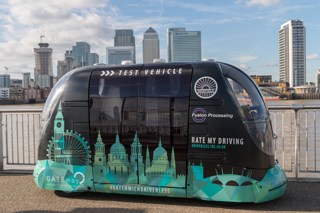A national competition to design roads fit for driverless cars and the growth of the UK road network has shortlisted five entrants into the final round.
Chairman of the National Infrastructure Commission Sir John Armitt said he and the competition jury had found the quality of entries “very impressive”, particularly how the entrants sought to make maximum use of the infrastructure already available.
Roads for the Future sought ideas for preparing the UK’s road network for the growth of connected and autonomous vehicles (CAVs).
Armitt added: “We can see for ourselves the progress in developing cars for the future, with trials of driverless cars taking place across the country – we now need to make sure the technology on our roads keeps up.
“The creativity and ingenuity of all the entries we received was very impressive, with many making the most of our existing network to prepare for these latest innovations.
“These five entries clearly stood out and I look forward to seeing how their ideas develop further over the coming months.”
Launched in January with Highways England and Innovate UK, the Commission received 81 entries.
Sir John and chair of the judging panel Bridget Rosewell confirmed the five going through to the competition’s final round.
Roads for the Future competition shortlist:
Leeds City Council – examining how the data generated from digitally connected cars could be used to improve traffic light systems, allowing highway authorities to better manage traffic on their roads and reduce tailbacks.
The team will use models of roads across Leeds to test this idea.
AECOM – examining how smart signals could advise drivers and vehicles the speed they should drive at, so they arrive at the next set of traffic lights just as they turn green, helping to cut congestion and ending polluting ‘stop-go’ driving.
The concept will be tested using a simulation model of the A59 in York
Arup – looking at how kerbsides with fixed features such as double yellow lines, parking bays and bus stops could become more flexible, their use changing according to the time of day and levels of demand to meet the most pressing needs.
The team will select a typical high street in London to test their FlexKerbs model
City Science – based in Exeter, this entry examines how sections of existing roads could be dedicated to driverless cars, making it easier to manage any risk and integrate CAVs into the existing transport network.
Immense – addressing how the latest artificial intelligence could be used to help sat-nav systems to ‘learn’ better routes to improve the directions given, so that both driven and driverless cars could change course to avoid congestion.
Working with Oxfordshire County Council, the concept will be tested using simulations of four busy local roads: Abingdon Road, Thames Street, Oxpens Road, and Botley Road
These five teams will now receive up to £30,000 each to test their ideas, with a £50,000 prize available for the overall winner, to be announced later this autumn.
Roads for the Future’s chair of the judging panel Bridget Rosewell said: “We cannot afford to focus purely on the technology under the bonnet – we also have to consider how our roads will work to support new driverless cars from the moment they arrive.
“With 81 entries received, our Roads for the Future competition has demonstrated the keen interest there is across industry to be at the forefront of the technologies supporting the introduction of driverless cars.
“We wanted to see how the rules of the road, road design and traffic management could all be adapted to accommodate these new vehicles – and these five entries particularly demonstrated the exciting potential there is to make the best use of those we already have.”


















Login to comment
Comments
No comments have been made yet.